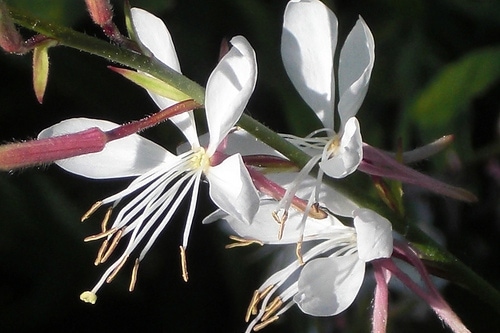Gaura, or the Oenothera genus, is a perennial herbaceous plant, member of Onagraceae family. Though it is not a European species, for a previous decade it was spread all over the Old Continent gardens majorly by a few most interesting looking varieties.
Thank you, Mr. Lindheimer!
Lindheimeri Beeblossom, Clockweed or Indian feather are only a few local names for Oenothera, formerly Gaura plant genus. Originally, Gaura is from North American continent, where it embellishes Texas and Louisiana landscape. Species got the name “lindheimeri” after “Father of Texas Botany” – Ferdinand Lindheimer who collected plant samples across Texas and Mexican frontier during 19-th century.
Gaura – a flowering chamaephyte
Gaura forms a branched subshrub that reaches 0,6–1,2 meters height and a 0,6–0,9 meters width growing out of underground branched rhizome. Stems are slender, elastic and hairy, green to purplish, depending on the assortment. Wooden stems are covered with thin floral branches, 20-80 cm long, which form a cluster blossom.
Flowers are four-petalled, 1-1,5 cm long, 3-4 cm diameter, with extremely long unilateral anthers. They are mostly white, or light to dark pink, opening from the base to the top of the inflorescence. Fragrant blossoms are full of nectar, so one can often notice swarms of bees and other insects above them. Thanks to these features, Gaura also has another name: the Beeblossom. Flowering is constant, unified, and lasts from June ‘till the first frosts. During the flowering period plant will form new stems that carrying new buds. And remain sexy and desirable for bees.
Landscaping or cut flowers?
The leaves are lanceolate, slightly hairy and scented. Color and size variate depending on assortment: leaves are green – monochromatic to multicolor, from 2,5 to 9 cm long. Oenothera plants love warm, sunny and well-drained positions.
Due to their morphological and aesthetic characteristics, the practice has shown that one can achieve excellent garden effect combining Gaura with annual flowers, ornamental grasses, and structural plants. Landscapers use them to create small groups in lawns, or simply as a hedge. Tall varieties are good for cutting flowers, while lower ones are often grown in containers and pots and can be nicely combined with balcony plants.
Pick a rocky spot in the garden
When it comes to soil selection, Lindheimers Beeblossom prefers moderately moist, light, easily draining even rocky lands. It is not a demanding species, and professional landscapers recommend its cultivation for less skilled gardeners. Also, advantages of this flower species are: it tolerates drought very well, it’s not prone to diseases and pests, and it will live long if you plant it in easily draining soil – it’s a must have!
Gaura growing technology
Growing Gaura is a somewhat simple process: one can sow seeds in cold greenhouses, or root softwood cuttings in spring (or semi-hardwood ones during summer).
Sowing: from February to mid-March in the seed boxes or directly in pots. Seed is rather large, oval, light brown and with deep creases. Germinability can last up to three years. Once you sowed it, cover the seed by a glass window with paper because of the sprouting in the dark. At 10-16º C temperature, it will grow for 20-28 days. If you sow it in containers, use sterilized substrate, and notice that pricking is done whžžen the second leaf appears (after cotyledons). Altogether production cycle lasts 14 weeks. During this period rust, powdery mildew and other fungal diseases may occur, so prevention measures and chemical protection is recommended.
Cuttings or sowing?
Production from cuttings is done during May and during the summer in June. You should prepare cuttings with at least two internodes, and place them into a substrate for rooting. For rooting itself you should provide 18-23º C temperature, after which you should transplant them into containers or directly to the planting spot. This way, Gaura can form a decorative hedge relatively quick.
One should replant such vernalized plantings to a permanent place after the last spring frosts at 35-45 cm distance, or 7-9 plants per m². You should know that on the first year Gaura will look unsightly, but it shouldn’t discourage new growers.
Tuck your plants in, please
So, in order gain maximal decorative effect, you should provide winter protection for your new garden tenant. Evergreens’ needles and hay straws will do just fine and do not use fallen old leaves for this. Pay attention that there should not be any retaining water around the plants during the cold period, otherwise it will easily rot and decay. In continental areas, during the winter above-ground parts will dry out and die back. Hence, during spring you should cut dry twigs, and shorten them to 10-15 cm in order to re-grow Gaura. If you wish to achieve more compact habitus, you should also shorten your Beeblossom next year as well.
Popular Gaura cultivars
Most commonly grown Gaura cultivars in this part of Europe are:
– Gaura lindheimeri “Siskiyou pink” – a so-called magic hybrid flower which petals are whitish in the morning, and become pink in the evening. This cultivar originated from Siskiyou Nursery in Oregon, USA.
– Gaura lindheimeri “Cherry brandy” – bronze leaves and dark pink buds on upper stems that will treat you with a long-lasting flower display

